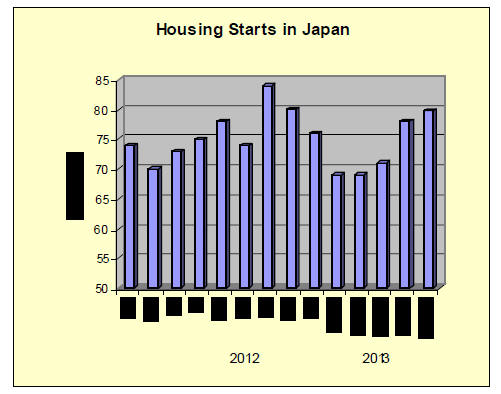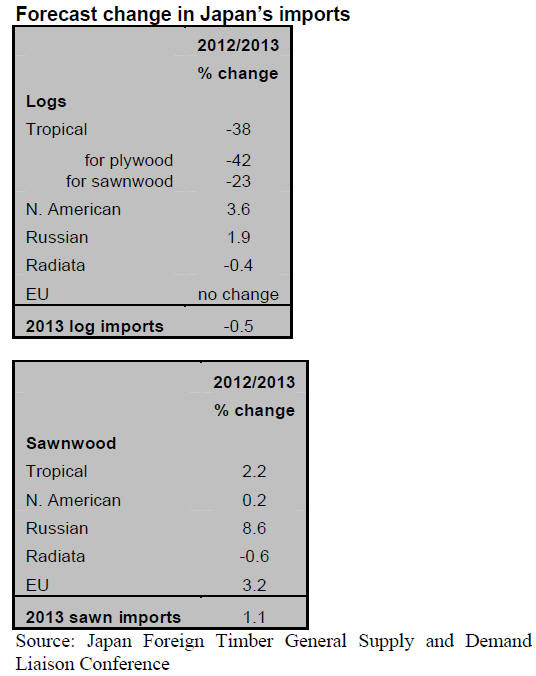Japan Wood Products
Prices
Dollar Exchange Rates of
27th June 2013
Japan Yen 99.15
Reports From Japan
JCER Outlook signals caution on inflation prospects
Analysts at Japan Center for Economic Research (JCER) are more cautious in
their forecasts for the Japanese economy than the Bank of Japan (BoJ), as is
evident in the latest JCER Outlook Report.
www.jcer.or.jp/eng/pdf/sa154-eng2.pdf
This report recommends caution regarding the likely effectiveness of the
“virtuous circle of production, income, and spending” and inflation
expectations.
The JCER report says “virtuous circle was one of the key terms used during
the previous economic recovery in the early 2000s.
However at that time terms of trade losses meant that the mechanism did not
function effectively and although GDP moved from negative to positive, this
was not enough to lift the economy out of its deflationary spiral”.
The similarity is drawn with conditions in early 2000 and today in Japan
where import bills are rising sharply because of the weaker yen and the
deficit is widening.
The JCER has doubts about inflation expectations also asking, do
expectations cause inflation, or does actual inflation uplift expectations?
Compounding the difficulty in making projections is the planned increase in
consumption tax.
The JCER says the looming increase in tax will result in ‘last minute
demand’ growth which could exceed expected levels such that afterwards there
is a sharp decline in consumer and business spending, perhaps even enough to
cause a slump in 2014.
Exports to US and China increased in May
Industrial output in Japan strengthened in May moving to a level not
recorded since 2011. The Cabinet Office report also shows retail sales grew
and the consumer price index remained flat bringing to an end the continuous
decline over the past six months.
Japan's exports also improved in May growing by around 10 percent, aided by
a weak yen and the better stability and modest improvement in overseas
demand. Exports to the US rose 16 percent from a year earlier while
shipments to China rose 8 percent.
This performance is seen as evidence that the efforts of the government to
break the deflationary spiral may be working.
But the weaker yen added to Japan’s already massive energy import costs,
leaving the country with a US$10 bil. trade deficit. However, analysts
consider the net effect of the weaker yen as offering promise for future
industrial expansion so remain positive on prospects for the economy.
Housing starts surge as buyers act to beat consumption tax hike
May housing starts in Japan totaled 79,751 a nearly 15% rise from April
bringing annualized starts to 1,027,000 starts, well above the forecast
950,000 units. May orders received by the 50 top construction companies in
Japan rose 26% year on year
The full details of housing starts in Japan can be found at:
http://www.e-stat.go.jp/SG1/estat/NewListE.do?tid=000001016966
Analysts attribute the steep rise as a reaction of buyers to the anticipated
increase in consumption tax due next year and to the desire of buyers to
secure mortgages at the cheapest rate possible.
Banks providing home loans in Japan are already imposing increased interest
rates for fix rate mortgages.

Japan’s tropical log imports forecast to fall sharply in 2013
The Japan Foreign Timber General Supply and Demand Liaison Conference has
released forecasts for timber imports in 2013.
While total demand for logs in 2013 is forecast to be as much as it was in
2012, demand for tropical logs is expected to fall by around 40% largely
because of the closure of one Japan’s major tropical plywood mill.
Statistics for first quarter imports shown below bear out the forecasts by
the Conference.

North American logs are utilised in Japan for sawnwood production and
2013 imports are expected to rise around 3%. Demand for Russian logs and
radiate pine logs is estimated to be about the same level as in 2012.
Japan imports significant volumes of tropical plywood and demand in 2013 is
forecast to be higher than in 2012 driven by increased activity in the
construction and house building sectors.

|